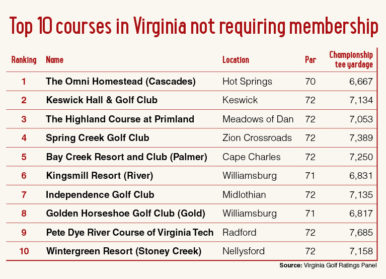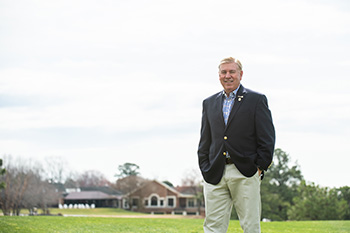A good walk improved
Virginia is home to some of the nation’s most beautiful — and demanding — golf courses
Don Harrison //March 29, 2020//
A good walk improved
Virginia is home to some of the nation’s most beautiful — and demanding — golf courses
Don Harrison //March 29, 2020//
The course at Kinloch Golf Club unfolds and reveals itself like an epic novel. Over the course of 19 holes — yes, 19 — its spectacular, elevated terrain clashes dramatically with its diabolical sporting challenges.
“Kinloch is wonderful,” says noted course designer Rees Jones, who has designed or restored more than 260 courses around the world. “It’s got as many shot options as any course in Virginia. It’s a place you enjoy playing over and over again, which is critical for a great course.”
“As you meander from hole to hole, the scenario changes,” confirms Vinny Giles, former U.S. and British amateur champion and co-designer of Kinloch, which opened in 2001. “Especially when you get to that sixth tee. All of a sudden, there’s a big lake that you didn’t know was there.”
The private course in eastern Goochland County, with its traditional caddy service and its faster bentgrass greens, was originally slated to be a daily fee course, but after a three-hour walk on the rustic, wooded property, Giles and builder Lester George recognized the land was special and deserved something different.
“I asked the owner if he’d consider a private membership club for golfers,” recalls Giles, a Lynchburg native who is the only amateur player inducted into the Virginia Golf Hall of Fame, which honors professionals. “Strictly golf, no swimming pools, no tennis court. He wanted to know why, and I told him this was a phenomenal piece of land that won’t be found this close to a metropolitan area, maybe ever again.”
Kinloch is ranked first on Golf Digest’s list of the best golf courses in Virginia and it takes the No. 2 slot on this year’s Virginia Business list of the commonwealth’s top courses (see Page 45). But it’s far from the only spectacular fairway layouts, public or private, to be found in the state. Virginia has many of the country’s best, most beautiful, most demanding courses and, even with challenges relating to changing demographics, high maintenance costs and marketing, they are ready for their closeup.
“I don’t know if Virginia properly advertises its golf, so many of its best destinations go unsung,” says Jones, who designed many courses in Virginia, including Stoney Creek at Wintergreen, The Club at Viniterra in New Kent County and Chesapeake’s Greenbrier Country Club. “I think the golf destinations of today are the ones that are really promoting themselves.”
 The Golden Horseshoe resort in Colonial Williamsburg is home to one of the nation’s most celebrated tee palaces, the 6,817-yard Gold Course, designed in 1963 by Jones’ late father, renowned golf architect Robert Trent Jones Sr. The legendary Jack Nicklaus still holds the course record, at 67.
The Golden Horseshoe resort in Colonial Williamsburg is home to one of the nation’s most celebrated tee palaces, the 6,817-yard Gold Course, designed in 1963 by Jones’ late father, renowned golf architect Robert Trent Jones Sr. The legendary Jack Nicklaus still holds the course record, at 67.
“It was one of my dad’s favorites,” says Jones, who has twice touched up the narrow, water-featured fairway, first in 1998 and again in 2017. “The greens have all different angles, shapes, contours; some go right, some left. In a lot of golf courses, you’ll see a lot of similarity in the greens. What makes the Gold Course the Gold Course is that every hole has a different twist. … That’s probably why it keeps players interested.”
Jones built a companion 7,120-yard Green Course at the Horseshoe in 1991. “My dad had more of the top of the hill, and I had more of the valleys and more wetlands to work around. When we did the Green, we also had to be careful in case we uncovered any historic Colonial artifacts.”
At the Omni Homestead Resort in Hot Springs, which dates back to 1766, golfers can experience another world-famous 18, the William S. Flynn-designed Cascades, home of numerous national U.S. championships (and the finest mountain course in the world, according to Giles). Set against the majesty of the Allegheny Mountains, the resort also offers the venerable Old Course, said to be the longest-running continuous green in the U.S., with its origins dating to 1892.
“It started as a six-hole layout,” says Jones, who renovated the Old Course 25 years ago. “Even though the Cascades gets all the publicity, and for good reason, these shorter, 6,200-yard golf courses — finesse courses — are really resonating because people can manage them. They’re attractive to many different skill levels. I’m building many shorter golf courses now.”
A new approach
In Virginia, clubs are adapting to changing times as the marketplace transitions from baby boomers to millennials, says David Norman, executive director of the National Golf Course Owners Association Mid-Atlantic, which represents golf courses in Washington, D.C., Maryland and Virginia. “The courses have been hosting more nine-hole tournaments and making sure that there’s craft beer on the beverage cart. It’s a different way of marketing to a generation that can also jump in the car, drive to Topgolf or Drive Shack, [and] hang out for an hour drinking beer and hitting golf balls.”
“Golf has changed,” acknowledges Jonathan Ireland, Kinloch’s general manager, “but it’s always been changing. How to get new, younger golfers into the game has become every club’s focus, and each is responding in its own way, from junior programs to offering legacy memberships.”
There’s a general movement to make golf more fun for everyday players, Norman adds, “by making sure that people play from a distance that is good and fits their game.” He cites a new trend to set up tee markers based on how far golfers can hit their initial tee shots. “Courses are actually putting these markers on the fairways.”
But a great golf course is [about] more than the game, Jones says. “Golf is also an experience. The views are why the game has resonated throughout history. … You go to a Kinloch or a Golden Horseshoe or a Primland, and it’s a different experience every time you go. The experience is as important as the challenge of the game.”
On the spectacular Highland Course at Patrick County’s Primland resort, which looks like it may have been cut out of the Scottish countryside, Brian Alley is blunt. “Let’s face it, we’re selling views here,” says the director of golf and recreation. “It’s an expensive thing to maintain. We hand-mow the greens every day and the tees and surrounds a couple of times a week.”

Of the resort’s 300 employees, 25 to 30 work on the beautifully manicured 7,034-yard course at peak season.
In the Roanoke Valley, Ballyhack Golf Club’s 7,300-yard Scottish-style links are nestled snugly on historic farmland, with the Blue Ridge Mountains serving as a powerful backdrop. “Ballyhack’s course conditioning is world-class and a focal point of our national destination model,” says General Manager Ian Sikes. “The bent and fescue grasses for which Ballyhack is known require year-round agronomic practices [to maintain].”
Missed opportunity?
Citing data he’s culled from NGCOA Mid-Atlantic members, Norman says good course conditions are the “No. 1 thing that golfers love — upkeep, landscaping, water features. You can have a beautiful course, but if it’s in poor condition, nobody is going to want to play it.”
That includes handling water issues appropriately, Giles says. “You’ve got to use the creeks to make sure your water is running off properly. Water drainage is key to a good course. And the environmental concerns are a critical part of the process, too. You have to be careful.”
Primland’s golf course is Audubon-certified, and its buildings LEED-certified, Alley notes. “Golf courses can be really friendly to nature or not. Courses can use tons of water and put pesticides out there, so there are many things to watch out for. We reuse a lot of water here.”
From the rustic charm of The Olde Farm in Bristol to the novelty tees at Meadows Farms in Orange County, where one hole is designed like a baseball diamond and another is Guinness World Records-certified as the world’s longest, the strength of Virginia golf is its diversity. While some respected courses have closed in Virginia over recent years — one was King Carter in Irvington, which Golf Digest had named “the best new affordable public course” in 2006 — David Norman thinks the downturn in the local golf industry that started in 2009 has bottomed out.

“It’s all about location,” says Norman, who was the Virginia State Golf Association’s executive director from 1991 to 2005. “Properly marketed, [Virginia] could be more of a golf destination. Virginia has the mountains, the Piedmont and the coast. Having four seasons is also a plus. I mean, you can open a course in February.”
Williamsburg has succeeded where other areas have not, says Kevin Brafford, executive director of Virginia Golf Ratings, an independent group that ranks the commonwealth’s top links. “Between Golden Horseshoe and Kingsmill, those are some of the top destinations in the country … but I don’t think Virginia as a whole has been in a position to market itself quite so well.”
Kinloch’s Ireland says it’s a missed opportunity. “Whether they are country clubs or daily fee facilities or private clubs like us, it’s a state with a great topography combination with lots of different characteristics suitable to golf, all within a drive.”
Selected services, like Virginia Golf Vacations, offer regional tours, Norman says, but attempts at an official Virginia Golf Trail have puttered away.
“At one point, 20 years ago, Virginia Tourism [Corp.] actually devoted a lot of funding toward marketing golf in Virginia,” he says. “Since then, they’ve turned their interests into other areas, particularly the wine and beer industries. So how well are we marketing golf to Canadians and to the Northeast and Midwest? Not very good. But does Virginia have the product to be viewed as a great national golf destination? Yes.”
“According to the research we’ve done, golf is not a primary driver for the people who come to Virginia,” says Joni Johnson, director of sales at VTC. Virginia Tourism does specifically market golf destinations to Canadians, she adds, but not to the rest of the country. Danish Saadat, a sales and marketing manager in charge of sports, says that VTC still promotes Virginia golf, pointing to several blog posts published on the Virginia Tourism website.
Read more from the golf package:
n















